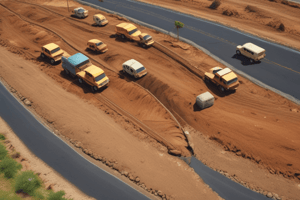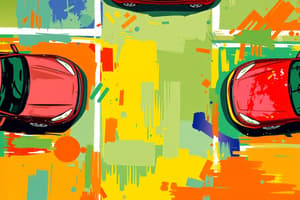Podcast
Questions and Answers
What is hill parking?
What is hill parking?
- Parking diagonally to the curb
- Parallel parking where the front wheels are turned to prevent rolling downhill (correct)
- A maneuver to turn your vehicle around
- Parking at a right angle to the curb
What is perpendicular parking?
What is perpendicular parking?
- A maneuver used to turn around
- Parking that requires more space than the vehicle
- Parking diagonally to a curb
- Parking at a right angle to the curb (correct)
What is a turnabout?
What is a turnabout?
- Backing into a driveway
- A maneuver used to turn your vehicle around (correct)
- A type of parking
- A method of identifying hazards
What does a convex mirror allow the driver to do?
What does a convex mirror allow the driver to do?
What is parallel parking?
What is parallel parking?
What is a forward reference point?
What is a forward reference point?
What is angle parking?
What is angle parking?
What is a reference point?
What is a reference point?
What is a standard reference point?
What is a standard reference point?
What is a personal reference point?
What is a personal reference point?
A mid-block U-turn requires a wide space because no backing is done.
A mid-block U-turn requires a wide space because no backing is done.
You should use the pull into the driveway on the right side turnabout when there is a driveway on the right and no traffic behind.
You should use the pull into the driveway on the right side turnabout when there is a driveway on the right and no traffic behind.
Which turnabout requires you to back across two lanes of traffic?
Which turnabout requires you to back across two lanes of traffic?
Which turnabout requires that you back into the traffic flow before moving forward?
Which turnabout requires that you back into the traffic flow before moving forward?
Which turnabout requires that you stop your car across traffic lanes?
Which turnabout requires that you stop your car across traffic lanes?
What is an escape path?
What is an escape path?
What does OVSP stand for?
What does OVSP stand for?
What are zones in relation to driving?
What are zones in relation to driving?
What is the path of travel?
What is the path of travel?
What is an open zone?
What is an open zone?
What is a space cushion?
What is a space cushion?
What is the field of vision?
What is the field of vision?
What is a closed zone?
What is a closed zone?
What does compromise space mean?
What does compromise space mean?
What does it mean to minimize a hazard?
What does it mean to minimize a hazard?
What is traction?
What is traction?
What is selective seeing?
What is selective seeing?
What is a target area?
What is a target area?
What is the 12-15 second range?
What is the 12-15 second range?
What is peripheral vision?
What is peripheral vision?
What is the 4-6 second range?
What is the 4-6 second range?
What is scanning in driving?
What is scanning in driving?
What are separate hazards?
What are separate hazards?
What is central vision?
What is central vision?
What is line of sight?
What is line of sight?
What are high beams used for?
What are high beams used for?
When should you use low beams?
When should you use low beams?
Flashcards are hidden until you start studying
Study Notes
Parking Techniques
- Hill Parking: Front wheels are turned to prevent rolling downhill when unattended; specific to sloped areas.
- Perpendicular Parking: Involves parking at a right angle to the curb; often used in parking lots.
- Angle Parking: Parking diagonally to the curb; common in many parking areas.
- Parallel Parking: Requires a space about six feet longer than the vehicle; essential skill for city driving.
Maneuvers and Reference Points
- Turnabout: A maneuver to turn the vehicle around to go in the opposite direction; various techniques exist depending on traffic and space.
- Forward Reference Point: Determines when to begin steering during a maneuver; crucial for precise parking techniques.
- Reference Point: An external or internal part of the vehicle used to relate to the roadway; helps with navigation.
- Standard Reference Point: A common reference point used by most drivers to aid in parking and maneuvering.
- Personal Reference Point: A unique point used by individual drivers as a reference; varies with each driver’s preferences.
Turnabout Types
- Mid Block U-Turn: Requires wide space with no backing maneuvers; typically used in open areas.
- Back Into Driveway On Right Side: Ideal when a driveway is available on the right with no traffic behind; facilitates easier turns.
- Pull Into Driveway On Right Side: Requires backing across two lanes of traffic; a more complex maneuver.
- Pull Into Driveway On Left or Right Side: Involves backing into traffic; requires careful assessment of oncoming vehicles.
- Three-Point Turnabout: Utilizes three steps and often stops across traffic lanes.
Visual Awareness and Space Management
- Escape Path: A designated area to go in case of potential conflicts; critical for safe navigation.
- OVSP (Orderly Visual Search Pattern): A process for systematically searching critical areas while driving.
- Zones: Six areas of space surrounding the vehicle; understanding them helps in assessing risks.
- Open Zone: A space free of restrictions affecting line of sight or path of travel; crucial for safe driving.
- Space Cushion: The area around the vehicle that is free from hazards and conflicts; essential for safe maneuvering.
Vision and Perception
- Field of Vision: The total area visible to the driver when looking straight ahead; understanding limits assists in safety.
- Closed Zone: A restricted space not allowing visibility or free travel; requires cautious navigation.
- Compromise Space: Allocating as much space as possible to the greater hazard when navigating risks.
- Minimize a Hazard: Strategy to reduce risk by increasing distance from potential hazards.
Driving Dynamics
- Traction: The gripping power between tires and road surface; fundamental for control and safety.
- Selective Seeing: The ability to focus on crucial clues or hazards relevant to the driving task; enhances situational awareness.
- Target Area: The area far ahead in the path of travel, including the left and right; important for strategic planning.
- 12-15 Second Range: Recommended distance for searching changes in the line of sight and path; allows for timely decision-making.
- Peripheral Vision: Awareness surrounding direct sight; aids in detecting movement or hazards outside the central vision.
Headlight Functions
- High Beams: Illuminate further, used on open country roads; shine about 500 feet ahead; should be switched off when other vehicles approach.
- Low Beams: Used in darkness to avoid blinding other drivers; typically shine about 150 feet ahead.
Scanning and Hazard Management
- Scanning: The process of conducting an orderly visual search pattern around the vehicle; enhances awareness of surroundings.
- Separate Hazards: The practice of adjusting speed to handle each hazard one at a time; important for safe navigation.
- Central Vision: The area of sight allowing for clear and sharp focus; critical for accurate navigation and obstacle detection.
- Line of Sight: The distance visible ahead in the direction of travel; helps assess potential obstacles and navigate effectively.
Studying That Suits You
Use AI to generate personalized quizzes and flashcards to suit your learning preferences.




